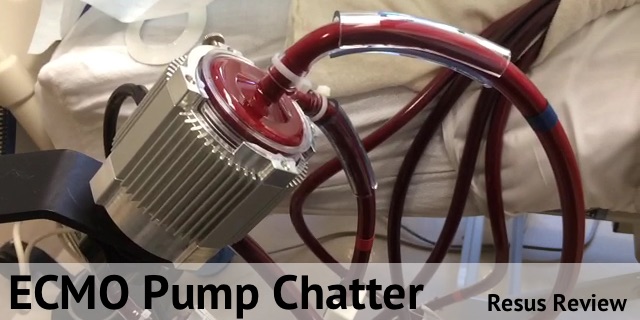
The ECMO Pump
The ECMO pump is centrifugal pump. This is different from renal dialysis circuits which are roller positive displacement pumps. As the centrifugal pumps spins, blood is draw in from the low-pressure side at the center of the pump. Rotors impart momentum (and hence pressure) to the blood as it moves centrifugally outwards. The fluid is then pulled off tangentially at the edge of the pump, at the higher pressure.
These pumps spin at an PMM set by the user. The blood flow rate (L/min) that is delivered at a given RPM, depends of the pressure gradient across the pump. This relationship is different between patients and in the same patient over time. Some of these factors can include:
- Volume status of patient
- Cannula size
- Vessel size and compliance
- Patient size
- Hematocrit
- Pressure gradient across oxygenator (eg. clotting)
- Patient’s native hemodynamics
ECMO Pump Chatter
As the pump RPMs, the pump generates a negative pressure on the patient venous side of the circuit in an attempt to increase the blood flow rate. However, there is a maximum flow rate that the circuit can pull from the patient. Past this point, the negative pressure in the venous system causes the venous vessels to collapse down against itself, temporarily stopping blood flow. When the pressure in the venous builds back up again after a few seconds, the blood flow begins again. This generates an erratic pulsing of the blood flow, and can cause cavitation of the pump. The RPM at which this occurs, defines the upper RPM and blood flow limit through the circuit.
At bedside you can place your hand on the pump itself and feel the chatter, or even more easily you can watch the venous tubing swing as the below video show.
Besides limiting blood flow, cavitation across the ECMO pump significantly cause damage to the venous blood vessels and increase hemolysis by the pump. This is monitored by a falling hemoglobin, and rising lactate dehydrogenase and bilirubin levels.
Correcting ECMO Cavitation
These easiest way to stop pump chatter/cavitation is to reduce the pump RPM and blood flow rate. However, this may not provide adequate hemodynamic support or gas exchange for the patient (based on lactate, ScvO2, etc.). If the patient requires the higher blood flows, you can try the follow options.
- Ensure adequate volume status (correct hypovolemia).
- Patient positioning.
- Cannula kinking.
- Malpositioned cannula.
- Upsize cannulas.
- Inspect tubing and cannula for kinking.
- Ultra for presence of any thrombus/cotting.
If you are forced to use lower blood flows because of chatter, it is useful to increase the patient’s oxygenation or hematocrit levels to provide additional oxygen carrying capability.
I have heard of chatter actually damaging the inferior vena cava
Excellent post Charles. Most common cause of chatter is usually hypovolemia (causing an under distended IVC) and will resolve with a fluid bolus. Other things to consider include on the inflow cannula:
– Malposition/cannula migration
– Kinking
– Thrombus
– Increased intra-abdominal pressure
Definitely taking my US to the bedside to have a direct look at the IVC and cannula tip. Keep up the great work!
We don’t have ECMO in our small town and so I found your blog really interesting and informative.
One last thought to consider in the video posted in a return of heart function causing movement in the ECMO circuit and not the sudden jerking or sucking down of the cannula on a vessel or wall like a fishing line would look.
[…] 27, 2021 ~ Juri Katchanov ECMO Pump Chatter ECMO Pump […]